Enhanced TDS
Identification & Functionality
- Chemical Family
- RTU Product Type
- Technologies
- Product Families
Features & Benefits
- Ready-to-Use Product Features
- Product Features
- 60-minute open time at RT
- Gap filling up to 30 mm
- Bright grey color (UV stable)
- Tolerant to ‘’less than ideal’’ pretreatment
- Tough flexible bonds for use in dynamic environments
- Product Properties
- 60 minutes open time at RT
- Gap filling up to 30 mm
- Bright grey color, UV stable
- Tough flexible bonds for use in dynamic environments
- Elongation at break of 100%
Applications & Uses
- Compatible Substrates & Surfaces
- Markets
- Applications
- Processing Information
Pretreatment
- The strength and durability of a bonded joint are dependent on proper pretreatment of the surfaces to be bonded, however the methacrylate adhesives can be used effectively with little surface preparation.
- Ideally joint surfaces should be cleaned with a good degreasing agent such as acetone, iso-propanol (for plastics) or other proprietary degreasing agents in order to remove all traces of oil, grease and dirt.
- Low grade alcohol, gasoline (petrol) or paint thinners should never be used.
- The strongest and most durable joints are obtained by either mechanically abrading or chemically etching (“pickling”) the degreased surfaces.
Application of adhesive
- The resin/hardener mix may be applied manually or robotically to the pretreated and dry joint surfaces.
- This adhesive system is available in side-by-side cartridges incorporating mixers and can be applied as ready to use adhesive using standard manual, pneumatic or battery dispersers. The cartridges should not be stored or preheated at temperatures above 30°C as it may cause the cartridge to fail and create a leak.
- The adhesive system can also be applied using a dosing and dispensing equipment which has been designed for methyl-methacrylate adhesives.
- A layer of adhesive 0.25 mm thick will normally impart the greatest lap shear strength to the joint.
- The joint components should be assembled and secured in a fixed position within the open time.
Warning: because the cure reaction can generate a high amount of heat, it is not recommended to mix amounts above 200 Grams in a container at room temperature.
Properties
- Physical Form
Technical Details & Test Data
- Typical Cured Properties
- Unless otherwise stated, the figures given below were all determined by testing standard specimens made by lap-jointing 114 x 25 x 1.6 mm strips.
- The joint area was 12.5 x 25 mm in each case.
- The figures were determined with typical production batches using standard testing methods.
- They are provided solely as technical information and do not constitute a product specification.
Average lap shear strengths of typical metal-to-metal joints (ISO 4587) (typical average values)
Cured for 24 hours at RT and tested at 23C, substrates sandblasted and degreased with acetone.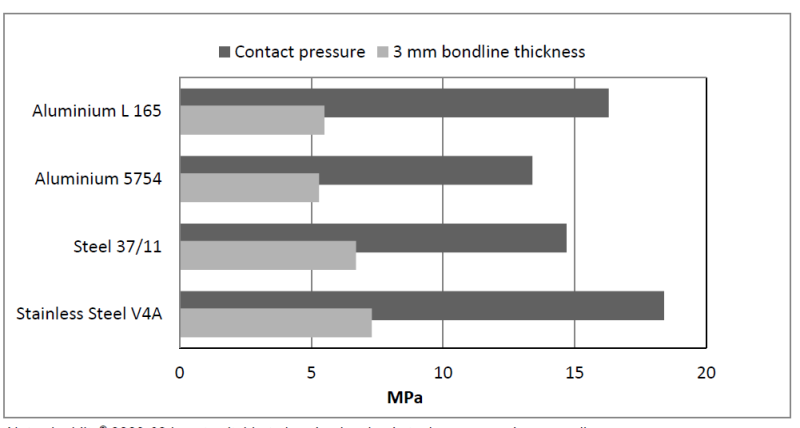
Note: ARALDITE® 2023-60 is not suitable to bond galvanized steel, copper and copper alloys.
Average lap shear strengths of typical plastic-to-plastic joints (ISO 4587) (typical average values)
Cured for 24 hours at RT and tested at 23°C. Substrates abraded and degreased with isopropanol.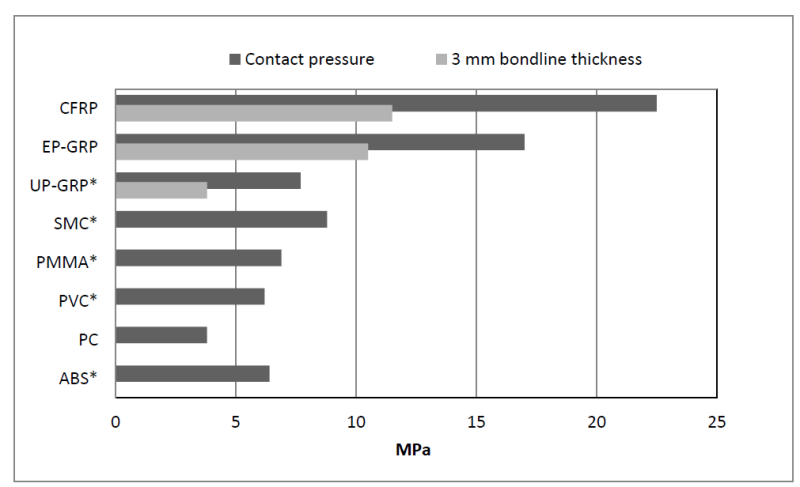
(*): UP-GRP, SMC; PMMA, PVC, substrate failure observed.
Yellowing under UV light (Typical average values)
Cure 7 days at RT
No yellowing after 1000 hours Atlas Suntest XLS+ / 500 W/m²Glass Transition Temperature (DMA) (Typical average values)
Cure 7 days at RT
Onset - 49°C
Midpoint - 81°CTensile Properties (ISO 527) (Typical average values)
Cure 7 days at RT and test at 23°C
Tensile Strength - 21 MPa
Tensile Modulus 700 - 800 MPa
Elongation at break - ca. 100%Lap shear strength versus temperature (ISO 4587) (typical average values)
On aluminium, pretreatment: sand blasting. Cure: 24 hours at RT.
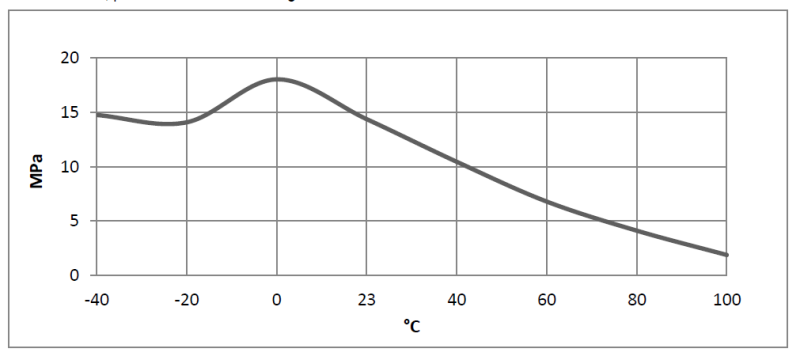
Lap shear strength versus tropical weathering (ISO 4587) (typical average values)
Aging at 40°C / 92% RH. Cure: 7 days at RT. Test at 23°C
Lap shear strength versus immersion in various media (ISO4587) (typical average values)
Cure: 7 days at RT Tested at 23°C.
Lap Shear Strength was determined after immersion for 30, 60 and 90 days at 23°C.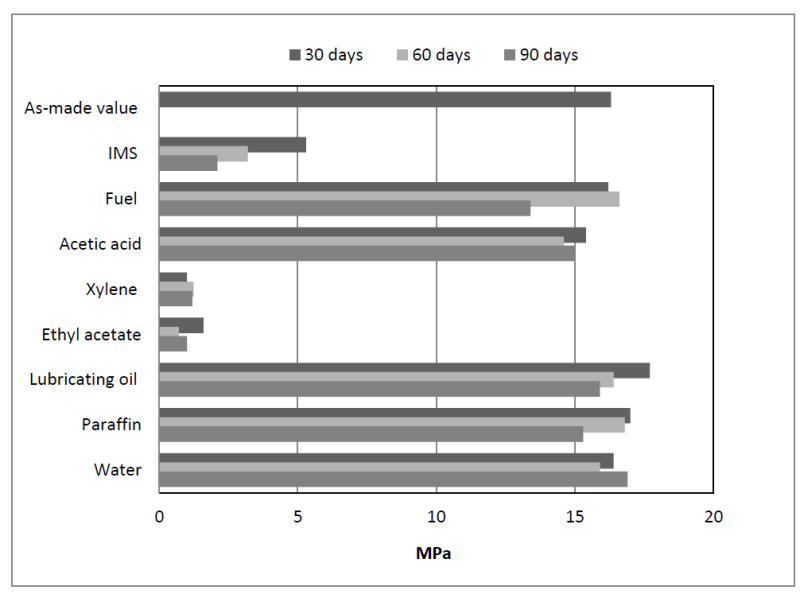
Lap shear strength versus heat ageing and thermal cycling (typical average values)
Cure: 7 days at RT. Test at 23°C
Thermal cycling 100 cycles ( 2h -30°C / 1 h up to 70°C / 2h 70°C / 1h down to -30°C)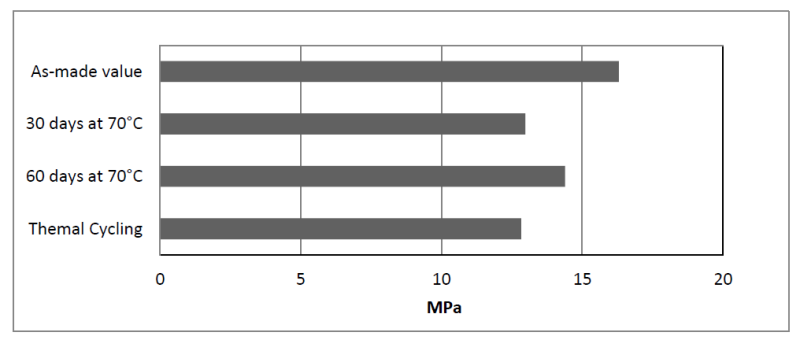
Lap shear strength versus Cataplasma ageing (typical average values)
Cure 7 days at RT – Cataplasma according to ISO 9142/E2 - Test: at 23°C
Metals sandblasted and degreased / plastics abraded and degreased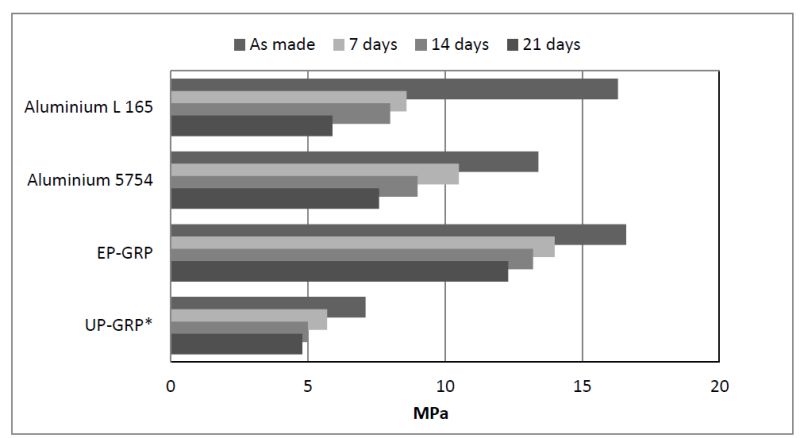
(*): UP-GRP: substrate failure observed
- Typical Times to Minimum Shear Strength on Sandblasted Aluminum / Contact Pressure
Temperature (°C) 10 23 40 Cure time to reach Lap Shear Strength > 1 MPa (hours) 5 - - Cure time to reach Lap Shear Strength > 1 MPa (minutes) - 100 45 Cure time to reach Lap Shear Strength > 10 MPa (hours) 7 2 - Cure time to reach Lap Shear Strength > 10 MPa (minutes) - - 60 - Equipment Maintenance
- All tools should be cleaned with hot water and soap before adhesives residues have had time to cure.
- The removal of cured residues is a difficult and time-consuming operation.
- If solvents such as MEK are used for cleaning, operatives should take the appropriate precautions and, in addition, avoid skin and eye contact.
Packaging & Availability
- Regional Availability
Storage & Handling
- Storage and Shelf Life Information
- The resin ARALDITE® 2023-60 A may be stored during 24 months at 2 – 8°C or 12 months at 8 – 25°C provided the component is stored in the original sealed container.
- The expiry date is indicated on the label assuming a storage at 2 – 8°C (24 months).
- The Hardener ARALDITE® 2023-60B may be stored during 18 months at 2 – 8°C or 12 months at 8 – 25°C provided the component is stored in the original sealed container.
- The expiry date is indicated on the label assuming a storage at 8 - 25°C (12 months).
- The cartridges of ARALDITE® 2023-60 may be stored during 18 months at 2 – 8°C or 6 months at 8 – 25°C provided the components are stored in the original sealed containers.
- The expiry date is indicated on the label assuming a storage at 2 - 8°C (18 months).
- The cartridges should never be stored at temperatures higher than 30°C as it may cause a leak.
- Handling Information
- It is generally quite harmless to handle provided that certain precautions normally taken when handling chemicals are observed.
- The uncured materials must not, for instance, be allowed to come into contact with foodstuffs or food utensils, and measures should be taken to prevent the uncured materials from coming in contact with the skin, since people with particularly sensitive skin may be affected.
- The wearing of impervious rubber or plastic gloves will normally be necessary; likewise the use of eye protection.
- The skin should be thoroughly cleansed at the end of each working period by washing with soap and warm water.
- The use of solvents is to be avoided. Disposable paper - not cloth towels - should be used to dry the skin.
- Adequate ventilation of the working area is recommended.
Other
- Application Information
Value Units Test Method / Conditions Mix Ratio 0.1 - Hardener : Resin - Mechanical Properties
Value Units Test Method / Conditions Hardness 62.0 - ISO 868 at 23°C Tensile Strength 22.0 MPa MPa ISO 527 at 23°C Tensile Strength 31.0 MPa MPa ISO 527 at 0°C Tensile Strength 3.0 MPa MPa ISO 527 at 100°C Tensile Strength 44.0 MPa MPa ISO 527 at -20°C Tensile Strength 54.0 MPa MPa ISO 527 at -40°C Tensile Strength 15.0 MPa MPa ISO 527 at 40°C Tensile Strength 11.0 MPa MPa ISO 527 at 60°C Tensile Strength 6.0 MPa MPa ISO 527 at 80°C - Physical Properties
Value Units Test Method / Conditions Density 1.09 g/cm³ g/cm³ Density 1.29 g/cm³ g/cm³ ISO 1183 at 23°C, cured Glass Transition Temperature (Tg) 40.8 °C °C ISO 6721 Onset Glass Transition Temperature (Tg) 79.3 °C °C ISO 6721 Peak Lap Shear Strength 15.5 MPa MPa ISO 4587 at 23°C, on sandblasted aluminium 5754
